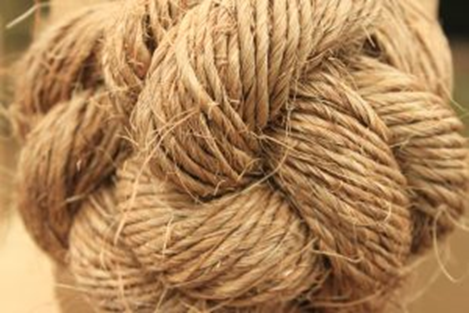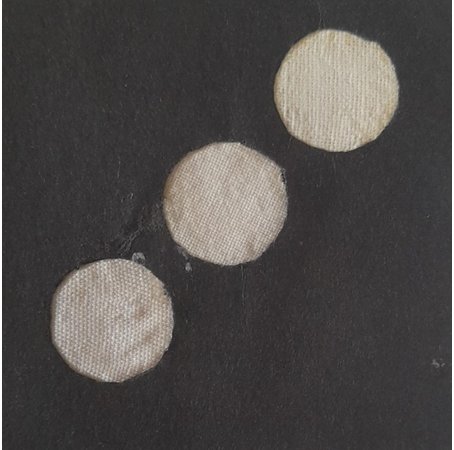WHAT IS BAGASSE FIBRE USED FOR?
INTRODUCTION
India endowed with an abundant availability of natural fiber such as Jute, Coir, Sisal, Pineapple, Ramie, Bamboo, Banana etc. has focused on the development of natural fiber composites primarily to explore value-added application avenues. Such natural fiber composites are well suited as wood substitutes in the housing and construction sector. The development of natural fiber composites in India is based on two pronged strategy of preventing depletion of forest resources as well as ensuring good economic returns for the cultivation of natural fibers.
The developments in composite material after meeting the challenges of sector have cascaded down for catering to domestic and industrial applications. Composites, the wonder material with light-weight; high strength-to-weight ratio and stiffness properties have come a long way in replacing the conventional materials like metals, wood etc. The material scientists all over the world focused their attention aerospace on natural composites reinforced with Jute, Sisal, Coir, Pineapple etc. primarily to cut down the cost of raw materials.
DEFINATION OF COMPOSITE
Van Suchetclan explains “composite materials as heterogeneous materials consisting of two or more solid phases, which are in intimate contact with each other on a microscopic scale. They can be also considered as homogeneous materials on a microscopic scale in the sense that any portion of it will have the same physical property”.
HISTORY OF COMPOSITES
Composites are structures that are made up of diverse elements, with the principle being that the sum of the whole is greater than the sum of its component parts (i.e. 1+1=3). An understanding of composites seems to be inherent in animal behavior, evident in the nest building of birds, bats and insects, for example. Primitive man used the basic materials that were available to him such as animal dung, clay, straw and sticks to form composite structures that were literally the first building blocks of civilization. Even the biblical Noah’s Ark was allegedly made of coal-tar pitch and straw, which could perhaps be the first reported construction of a reinforced composites boat! Moving forward several thousand years, and the second wave of the industrial revolution that swept though western Europe from the1830s onwards, saw new found industries developing their own composite technologies such as laminated wood, alloyed metals and steel reinforced concrete. The earliest polymer castings were developed by Lepage in France using albumen, blood and wood flour to produce decorative plaques. The first semi – synthetic plastics were produced when cellulose fibres were modified with nitric, acid to form cellulose nitrate – or celluloid as it was to become known. Phenolic, trade named Bakelite by its Belgian born US inventor L.H.Baekeland, was the first wholly synthetic plastic material. As well as being used for decorative items such as umbrella stands and pipe stems, phenolic was also used to make components for the emerging electrical, telephone and radio industries. Different fillers such as wood flour, mica, asbestos and textile fabric were used to enhance the heat resistance and insulating properties of the resin. For the first half of the 20th century, phenolic resins were dominant. However the emergence of the more versatile and userfriendly polyester resins in the 1940s opened up whole new markets for composites. Wars tend to give a major boost to technological development. Such was the case in the early years of the Second World War, when new structural materials were needed to complement the use of the emerging radar technology. Glass fiber reinforced polyester composites fitted the bill perfectly – providing protective housings for radar antenna, which are transparent to radio waves. When the war was over, a new set of imperatives emerged which further drove the wider use of glass fiber reinforced plastics, or GRP as it was becoming known.
Firstly a major infrastructure and rebuilding program was necessary and traditional materials such as steel were in short supply. Secondly there was a growing sense of the need for change and future orientation – especially when the space race got underway in the late 1950s – generating a spirit of optimism that favoured the experimentation and adoption of new materials; and finally there was the practical benefits in that the price of glass fiber and resins began to decrease as new capacities came on stream. Several industries quickly picked up on the very special benefits that polyester composites could offer. For example boat builders found in GRP moulding an excellent way of mass producing hulls and superstructures; truck and car builders realized it was a material that was pound-for-pound stronger than steel and did not rust or dent; and fabricators of tanks and pipes recognized GRP as a material that was lighter and more chemically resistant than traditional materials such as metals and concrete. The result was that the ten year period 1955 to 1965 was the ‘big bang’ for composites GEOTEXTILES AND ITS APPLICATION – an explosive decade for composite developments and applications, the likes of which may never be seen again. From the late 60s to late 70s, the oil crisis and cyclical global recessions put the brakes on the runaway success of thencomposites industry. The aftermath of this period saw a more responsible approach emerge. Many businesses collapsed during this period and many raw material producers either withdrew from the market or consolidated their businesses. Those companies looking to make a quick killing were replaced by more professional and responsible suppliers and producers who were there for long term growth and not for short term gain.
- WHY COMPOSITE?
Over the last thirty years composite materials, plastics and ceramics have been the dominant emerging materials. The volume and number of applications of composite materials have grown steadily, penetrating and conquering new markets relentlessly. Modern composite materials constitute a significant proportion of the engineered materials market ranging from everyday products to sophisticated niche applications. While composites have already proven their worth as weight-saving materials, the current challenge is to make them cost effective. The efforts to produce economically attractive composite components have resulted in several innovative manufacturing techniques currently being used in the composites industry. It is obvious, especially for composites, that the improvement in manufacturing.
- CHARACTERISTICS OF THE COMPOSITES
Composites consist of one or more discontinuous phases embedded in a continuous phase. The discontinuous phase is usually harder and stronger than the continuous phase and is called the ‘reinforcement’ or ‘reinforcing material’, whereas the continuous phase is termed as the ‘ matrix’.
Properties of composites are strongly dependent on the properties of their constituent materials, their distribution and the interaction among them. The composite properties may be the volume fraction sum of the properties of the constituents or the constituents may interact in a synergistic way resulting in improved or better properties. Apart from the nature of the constituent materials, the geometry of the reinforcement (shape, size and size distribution) influences the properties of the composite to a great extent. The concentration distribution and orientation of the reinforcement also affect the properties.
The shape of the discontinuous phase (which may by spherical, cylindrical, or rectangular cross-sanctioned prisms or platelets), the size and size distribution (which controls the texture of the material) and volume fraction determine the interfacial area, which plays an important role in determining the extent of the interaction between the reinforcement and the matrix.
Concentration, usually measured as volume or weight fraction, determines the contribution of a single constituent to the overall properties of the composites. It is not only the single most important parameter influencing the properties of the composites, but also an easily controllable manufacturing variable used to alter its properties
- COMPONENTS OF A COMPOSITE MATERIAL
In its most basic form a composite material is one, which is composed of at least two elements working together to produce material properties that are different to the properties of those elements on their own. In practice, most composites consist of a bulk material (the ‘matrix’), and a reinforcement of some kind, added primarily to increase the strength and stiffness of the matrix.
1.MATRIX
Many materials when they are in a fibrous form exhibit very good strength property but to achieve these properties the fibres should be bonded by a suitable matrix. The matrix isolates the fibres from one another in order to prevent abrasion and formation of new surface flaws and acts as a bridge to hold the fibres in place. A good matrix should possess ability to deform easily under applied load, transfer the load onto the fibres and evenly distributive stress concentration.
2.REINFORCEMET
The role of the reinforcement in a composite material is fundamentally one of increasing the mechanical properties of the neat resin system. All of the different fibers used in composites have different properties and so affect the properties of the composite in different ways. For most of the applications, the fibers need to be arranged into some form of sheet, known as a fabric, to make handling possible. Different ways for assembling fibers into sheets and the variety of fiber orientations possible to achieve different characteristics.
3.INTERFACE
It has characteristics that are not depicted by any of the component in isolation. The interface is a bounding surface or zone where a discontinuity occurs, whether physical, mechanical, chemical etc. The matrix material must “wet” the fibre. Coupling agents are frequently used to improve wettability. Well “wetted” fibres increase the interface surfaces area. To obtain desirable properties in a composite, the applied load should be effectively transferred from the matrix to the fibres via the interface. This means that the interface must be large and exhibit strong adhesion between fibres and matrix. Failure at the interface (called debonding) may or may not be desirable.
4.CLASSIFICATION OF COMPOSITE
The two broad classes of composites are
(1) Particulate composites and
(2) Fibrous composites.
1.Particulate Composites
As the name itself indicates, the reinforcement is of particle nature (platelets are also included in this class). It may be spherical, cubic, tetragonal, a platelet, or of other regular orirregular shape, but it is approximately equiaxed. In general, particles are not very effective in improving fracture resistance but they enhance the stiffness of the composite to a limited extent. Particle fillers are widely used to improve the properties of matrix materials such as to modify the thermal and electrical conductivities, improve performance at elevated temperatures, reduce friction, increase wear and abrasion resistance, improve machinability, increase surface hardness and reduce shrinkage.
2 .Fibrous composites
A fiber is characterized by its length being much greater compared to its cross- sectional dimensions. The dimensions of the reinforcement determine its capability of contributing its properties to the composite. Fibers are very effective in improving the fracture resistance of the matrix since a reinforcement having a long dimension discourages the growth of incipient cracks normal to the reinforcement that might otherwise lead to failure, particularly with brittle matrices.
Man-made filaments or fibers of non polymeric materials exhibit much higher strength along their length since large flaws, which may be present in the bulk material, are minimized because of the small cross-sectional dimensions of the fibre In the case of polymeric materials, orientation of the molecular structure is responsible for high strength and stiffness. Fibers, because of their small cross- sectional dimensions, are not directly usable in engineering applications. They are, therefore, embedded in matrix materials to form fibrous composites. The matrix serves to bind the fibers together, transfer loads to the fibers, and protect them against environmental attack and damage due to handling. In discontinuous fibre reinforced composites, the load transfer function of the matrix is more critical than in continuous fibre composites.
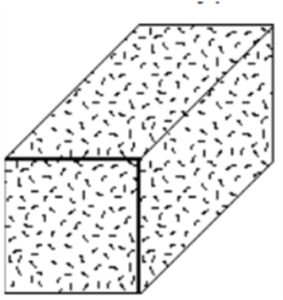
Fig: Short fiber composites
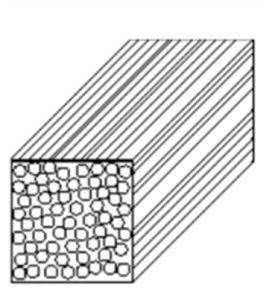
fig: Long fiber composites
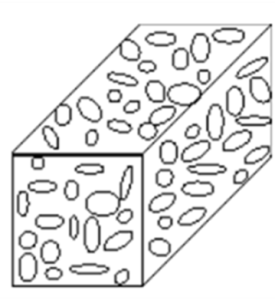
Fig: Flake composites
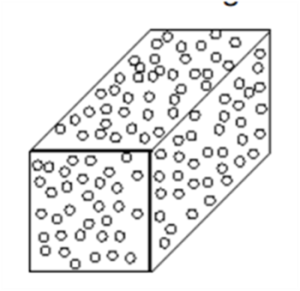
fig: Particulate composites
- RAW MATERIALS
Raw materials used in this experimental work are:
- Natural fiber (Bagasse)
- Epoxy resin
- Hardener
- BAGASSE FIBRE
The sugar cane bagasse is a residue widely generated in high proportions in the agro-industry. It is a fibrous residue of cane stalks left over after the crushing and extraction of juice from the sugar cane. Bagasse is generally gray-yellow to pale green in colour. It is bulky and quite non uniform in particle size. The sugar cane residue bagasse is an underutilized, renewable agricultural material that consists of two distinct cellular constituents. The first is a thick walled, relatively long, fibrous fraction derived from the rind and fibro-vascular bundles dispersed throughout the interior of the stalk. The second is a pith fraction derived from the thin walled cells of the ground tissue. The main chemical constituents of bagasse are cellulose, hemicellulose and lignin. Hemicellulose and cellulose are present in the form of hollow cellulose in bagasse which contributes to about 70 % of the total chemical constituents present in bagasse. Another important chemical constituent present in bagasse is lignin. Lignin acts as a binder for the cellulose fibers and also behaves as an energy storage system.
- EPOXY RESIN
Softener (Araldite LY 556) made by CIBA GUGYE limited having the following outstanding properties has been used as the matrix material.
- Excellent adhesion to different materials.
- High resistance to chemical and atmospheric attack.
- High dimensional stability.
- Free from internal stresses.
- Excellent mechanical and electrical properties.
- Odorless, tasteless and completely nontoxic.
- HARDENER
In the present work hardener (HY951) is used. This has a viscosity of 10-20 MPa at 2 5 º c.
- PREPARATION OF COMPOSITES:
THE FOLLOWING PROCEDURE HAS BEEN ADOPTED FOR THE PREPARATION OF THE COMPOSITE
Bagasse fiber preparation:-
Fresh bagasse fibers were collected after they were crushed for extracting juice by using a hand crushing machine. These fibers were then spread on a water proof sheet to reduce the moisture content. After approximately two weeks, the long bagasse fibers were shortened into a length of 10mm, breadth of 1mm and width of 1mm with a pair of scissors. Small size fibers were selected in order to design a composite with consistent properties. Due to the low moisture content of the bagasse samples, no fungi grew during the storage. The bagasse samples were then cleaned via pressurized water for about one hour. This procedure removes fine bagasse particles, sugar residues and organic materials from the samples. Then the fibers were dried with compressed air.
Composite preparation:-
A wooden mold of dimension (120x100x6) mm was used for casting the composite sheet. The first group of samples were manufactured with 5, 10, 20 % volume fraction of fibers. For different volume fraction of fibers, a calculated amount of epoxy resin and hardener (ratio of 10:1 by weight) was thoroughly mixed with gentle stirring to minimize air entrapment. For quick and easy removal of composite sheets, mold release sheet was put over the glass plate and a mold release spray was applied at the inner surface of the mold. After keeping the mold on a glass sheet a thin layer (» 2 mm thickness) of the mixture was poured. Then the required amount of fibers was distributed on the mixture. The remainder of the mixture was then poured into the mold. Care was taken to avoid formation of air bubbles. Pressure was then applied from the top and the mold was allowed to cure at room temperature for 72 hrs. This procedure was adopted for preparation of 5, 10 and 20% fiber volume fractions of composites. After 72 hrs the samples were taken out of the mold, cut into different sizes and kept in air tight container.
7.ADVANTAGES OF COMPOSITES:
- Combination of high strength and stiffness with low density Reduced in-service cost.
- High corrosion resistance Reduced maintenance cost.
- Flexibility in design and production Parts integration, shape flexibility.
- Improved fatigue behaviour Reduce in-service and maintenance cost.
- Specific properties (ex. Zero thermal expansion, radar transparency).
- Renewable
- Can be thermally recycled (posses a good calorific value)
- Give less problem concerning health and safety of workers
- Less abrasive, Good specific properties
- Good thermal and acoustic properties
- Excellent price-performance
8.DIS-ADVANTAGES OF COMPOSITE:
- High constituent materials cost increased production cost.
- Anisotropic behaviour Complex design calculations increased production cost.
- New joining and repair technologies Increased maintenance cost.
- Complex damage development during service Increased maintenance cost.
- Difficult to recycle increased end-of-life cost.
- Fluctuation in quality, price and availability.
- Dimension instability.
- Susceptibility to rotting, Moisture Adsorption, Swelling leads to micro-cracking.
- Restricted processing temperature, Low strength.
- Smell of natural fibers when process at high temperature.
APPLICATION OF COMPOSITE:
1.Building Products:
Decking
Window/Door and Fencing
Decorative Trim and Railings
2.Infrastructure:
Boardwalks
Bridge
Guardrails
3.Marine:
Small fishing boats
4. Transportation:
Interior Panel
Shelves
Ducting and Truck Floor
Head liners
5. Industrial/Consumer:
Pallets
Playground
Benches/Tables
Floorings and Trash
CONCLUSION
The natural fibers have attracted substantial importance as a potential structural material. The attractive plus point of natural fiber si n terms of industrial usage has made its availability more demanding Keeping this in view the present work has been undertaken to develop a polymer matrix composite (epoxy resin) using bagasse fiber as reinforcement and to study its mechanical properties and performance. The composites are prepared with different volume fraction of bagasse fiber.
Usually the fiber reinforcement is done to obtain high strength and high modulus. Hence it is necessary for the fiber to possess higher modulus than the matrix material. So the load is transferred to the fiber from the matrix more effectively. Fiber reinforced composites are popularly being used in many industrial applications because of their high specific strength & stiffness. Due to their excellent structural performance these composites are gaining potential also in tribological applications. Usually the fiber reinforcement is done to obtain high strength and high modulus. Hence it is necessary for the fiber to possess higher modulus than the matrix material. So the load is transferred to the fiber from the matrix more effectively. Fiber reinforced composites are popularly being used in many industrial applications because of their high specific strength & stiffness. Due to their excellent structural performance these composites are gaining potential also in tribological applications.
The sugar cane bagasse waste as reinforcement to polymeric resins for fabrication of low cost composites.

